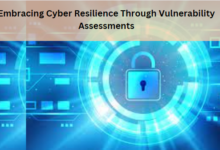Key Takeaways:
- Vulnerability assessments are critical for detecting security weaknesses.
- Understanding vulnerability assessments can aid in proactive threat management.
- Regular assessments inform better cybersecurity strategies and business resilience.
- Awareness and training enhance the effectiveness of security measures.
In today’s digital landscape, the threat of cyber attacks looms large, posing significant risks to organizations of all sizes and industries. To fortify their defenses against ever-evolving threats, businesses must adopt proactive measures to bolster their cyber resilience. One such approach is through vulnerability assessments, which play a crucial role in identifying and addressing potential weaknesses in an organization’s cybersecurity posture.
Vulnerability assessments are a critical aspect of any comprehensive cybersecurity strategy. They provide insight into the potential chinks in the armor of an organization’s network security, allowing for proactive measures to be put in place before a breach occurs. Implementing regular assessments promotes a greater understanding of threats, enabling businesses to strengthen their cybersecurity. In the ever-evolving landscape of digital threats, embracing the practice of periodic vulnerability assessments is not just a technical necessity but a cornerstone of business resilience. This deep dive explores the multifaceted role of vulnerability assessments in safeguarding modern enterprises.
Resources like Fortinet’s guide on vulnerability assessments can offer a thorough understanding of the process to ensure organizations are well-versed in its nuances.
Deconstructing Vulnerability Assessments
At its core, a vulnerability assessment systematically evaluates an organization’s IT estate to identify security vulnerabilities. These assessments must be carried out frequently to align with modern business environments’ dynamic cyber threat landscape.
Effective vulnerability management is critical in preemptive threat mitigation, enabling businesses to identify vulnerabilities before malicious actors exploit them. Done correctly, vulnerability assessments can highlight potential threats across systems and software, safeguarding against unauthorized access and data breaches.
Critical Steps in Executing a Vulnerability Assessment
The process of performing a comprehensive vulnerability assessment begins with mapping out all IT assets and creating a precise inventory of the systems, applications, and networks in use. Following this, security professionals utilize various tools to scan these assets for known vulnerabilities, inspecting for obstacles such as outdated software, misconfigurations, or unpatched flaws.
The scanning phase is followed by a meticulous analysis of the compiled data to rank vulnerabilities based on their severity and potential impact on the organization’s operations. This ranking is critical for prioritizing which vulnerabilities should be addressed first, ensuring the effective allocation of resources.
Role of Vulnerability Assessments in Ensuring Business Continuity
Regarding business continuity, vulnerability assessments are a pre-emptive measure against incidents that can significantly disrupt operations.
This process aids in developing a risk management platform, providing a foundation for building resilience and continuity strategies. For instance, companies that have experienced cyber incidents often cite the absence of or inadequate vulnerability assessments as a reason for their vulnerability to attacks.
Adopting Best Practices for Robust Vulnerability Management
For vulnerability assessments to be practical, they need to be integrated into a company’s routine security protocols, following established best practices. These include setting a regular assessment schedule, ensuring all segments of the organization’s IT infrastructure are scrutinized, and establishing clear communication channels so that all stakeholders are informed and prepared to act on the findings.
Additionally, parallels should be drawn with human factors since promoting security awareness and training amongst staff can drastically reduce the likelihood of vulnerabilities resulting from human error or oversight.
Technology’s Influence on Modern Vulnerability Assessments
The integration of advanced technology into vulnerability assessments has significantly enhanced their effectiveness. Modern tools now frequently employ artificial intelligence (AI) and machine learning algorithms to predict better the avenues through which security breaches might occur.
This predictive capability allows organizations to adopt a forward-thinking approach to cybersecurity, mitigating potential threats before they become active issues.
Dissecting Vulnerability Assessment Reports
The final product of a vulnerability assessment is typically a detailed report that conveys the findings in an accessible manner. This report should translate the complex data into actionable insights, which can guide strategic responses to identified vulnerabilities. Understanding these reports is crucial for IT and security teams to promptly prioritize and remediate the most severe vulnerabilities.
Addressing the Challenges Around Vulnerability Assessments
Conducting vulnerability assessments is challenging, particularly for smaller organizations that may need help with the cost and sophistication of the process. Industry-specific considerations, particularly concerning data protection laws and regulations, also necessitate a balanced approach that aligns with the organization’s size, industry, and risk profile while maintaining a robust security posture.
Synchronizing Vulnerability Assessments with Broader Security Policies
Vulnerability assessments do not exist in a vacuum; they should be part of a broader security framework that includes policies, procedures, and practices tailored to the organization’s specific needs. This framework might include regular penetration testing, vigorous incident response planning, and thorough employee training programs to create a secure environment.
Learning from Practical Applications of Vulnerability Assessments
Case studies of both successful and failed vulnerability assessments provide a wealth of knowledge from which organizations can learn. Successful assessments often feature prompt identification and patching of vulnerabilities, strong coordination between departments, and a culture of continuous cybersecurity review. Conversely, practical assessments frequently need to address discovered vulnerabilities promptly or communicate severity to decision-makers, ultimately leading to preventable breaches.
Continuously refining cybersecurity strategies, informed by regular vulnerability assessments, is essential to bolster an organization’s defenses against cyber threats. As adversaries devise increasingly sophisticated ways to target networks, businesses must employ equally advanced measures to protect themselves. This proactive stance and heightened security awareness throughout the organization lays the groundwork for enduring cybersecurity.






